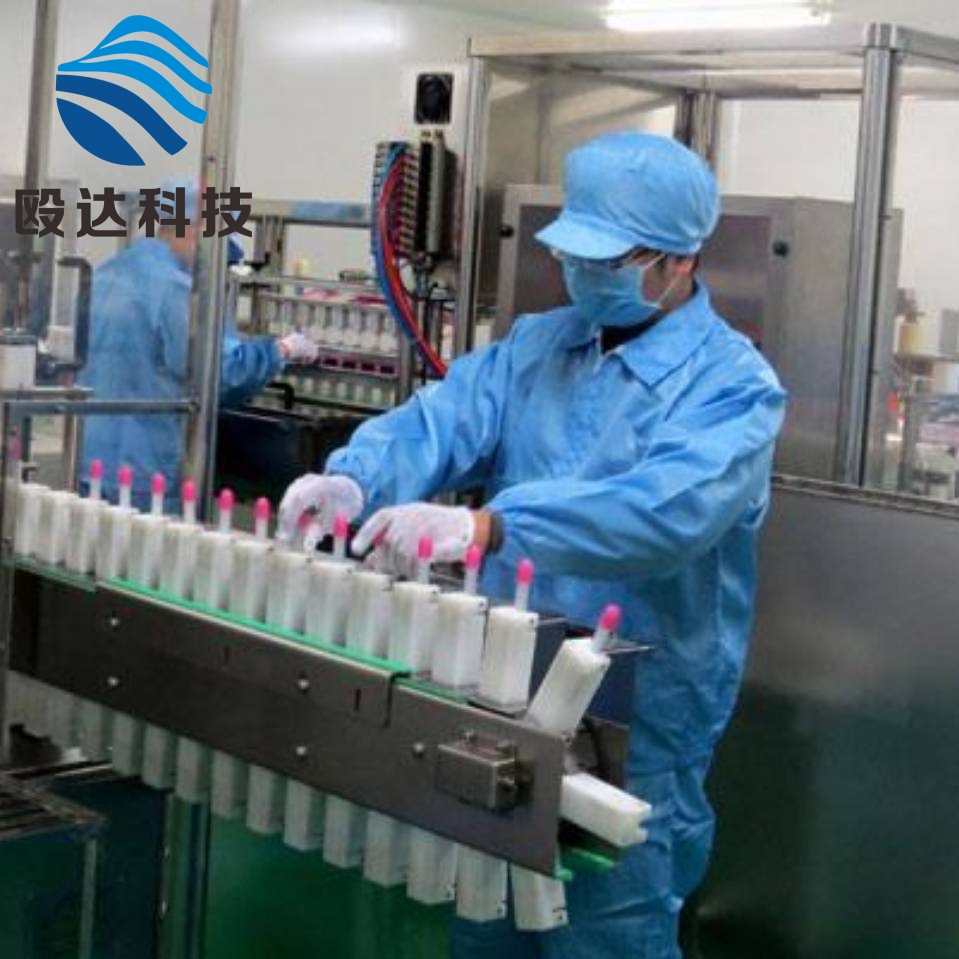-
Categories
-
Pharmaceutical Intermediates
-
Active Pharmaceutical Ingredients
-
Food Additives
- Industrial Coatings
- Agrochemicals
- Dyes and Pigments
- Surfactant
- Flavors and Fragrances
- Chemical Reagents
- Catalyst and Auxiliary
- Natural Products
- Inorganic Chemistry
-
Organic Chemistry
-
Biochemical Engineering
- Analytical Chemistry
- Cosmetic Ingredient
-
Pharmaceutical Intermediates
Promotion
ECHEMI Mall
Wholesale
Weekly Price
Exhibition
News
-
Trade Service
In the past two years, the outbreak of the new crown has caught all mankind by surprise
.
As of today, the novel coronavirus is still raging across much of the planet
.
Winter has come, the temperature has dropped sharply, and now it has entered the season of high incidence of epidemic viruses such as colds
.
With the emergence of the new mutant strain Omicron, many countries in the world have been very alert to this, and the global human beings also need to work together to control a new round of the outbreak of the new crown
.
No matter which variant is popular, the basic research behind it is urgent and necessary
.
The study of the molecular phenotype of urine is of great significance
.
Recently, Guo Tiannan's research group from the West Lake Laboratory of West Lake University published a research paper in Cell Reports entitled: Proteomic and metabolomic profiling of urine uncovers immune responses in patients with COVID-19
.
This study shows that the urine of patients with new coronary pneumonia is a completely non-invasive biological sample, and the biomolecules obtained from the urine can sensitively reflect the pathological state of the body
.
This study screened 20 protein markers from urine and established a model, which successfully achieved the purpose of classifying and predicting new crown patients; the study also pointedly put forward evidence of potential kidney damage in patients with new crown
.
Urine comes from the peripheral circulation and can be obtained without professional collection methods (compared to serum, tissue, etc.
), which can fully meet the requirements of daily real-time health monitoring
.
Using biomolecules in urine to monitor human health status has important practical value and practical significance for future precision medicine and precision anti-epidemic
.
A total of 115 urine and serum samples from the COVID-19 patient group and healthy controls were systematically studied
.
Using the analysis methods of proteomics and metabolomics, the patients in each group were studied and compared
.
From the protein level analysis, the urine protein expression per unit volume was significantly higher in the mild and severe COVID-19 groups compared with the healthy group, which suggests that urine may be more sensitive to changes in the body's disease level
.
A total of 1494 serum proteins, 3854 urine proteins, 903 serum metabolites, and 1033 urine metabolites were quantified in this study
.
The study found that the protein molecular weight distribution in urine is consistent with the protein molecular weight distribution of the whole human proteome, which means that urine samples will not miss a certain type of protein and cause information loss
.
Summary Analysis of Serum and Urine Proteomics and Metabolomics Data So can urine proteins reflect the molecular changes caused by COVID-19? The machine learning results show that the ability of urine protein to distinguish between mild and severe new coronary pneumonia is basically the same as that of serum protein
.
On this basis, the study established a machine learning model based on 20 urine proteins
.
During the outcome of severe COVID-19 patients, the predicted value of the model gradually decreased over time; while in mild recovered patients, the predicted value leveled off and did not change significantly
.
These results further confirmed the potential of these 20 urine proteins to classify and predict the severity of COVID-19
.
Distinguishing mild and severe COVID-19 patients at the proteomic level The study next explored the correlation between serum and urine of COVID-19 patients
.
The relative abundance of 301 proteins showed opposite expression patterns in urine and serum as the disease progressed (healthy-light-heavy)
.
The study found that two important regulators involved in renal tubular reabsorption, megalin (LRP2) and cubilin (CUBN), showed a downward trend in the urine levels of COVID-19 patients
.
The renal tubular reabsorption process may be dysregulated in patients with COVID-19, causing certain protein changes in urine to show different expression patterns than those in blood
.
This phenomenon may also exist in other diseases, and further research is needed
.
301 serum and urine proteins showed opposite expression patterns.
Cytokine storm caused by uncontrolled innate inflammatory response is the main cause of high mortality in COVID-19 patients, so this study also focused on cytokines in Expression in serum and urine
.
The study quantified 124 cytokines in serum and 197 in urine
.
In urine, CXCL14 was significantly correlated with lymphocyte counts in COVID-19 patients, or may be used to indicate the severity of COVID-19 disease
.
Cytokine signatures in urine and serum In addition, the study also found some proteins related to virus budding specifically in the urine proteome, which showed a significant down-regulation trend in the urine of COVDI-19 patients, and Not detected in serum
.
The above results indicate that in this study, the urine proteome showed higher detection sensitivity than the blood proteome
.
Virus budding-related proteins quantified in urine showed differential expression patterns in healthy controls and COVID-19 patients.
Through differential pathway analysis, many proteins that frequently appeared in differentially expressed pathways were obtained
.
Among them, CDC42, RAC1/RAC2 and RHOA of the Rho GTPase family appeared most frequently
.
Dysregulation of these proteins may lead to glomerulosclerosis and kidney damage
.
Furthermore, the dynamic regulation of renal podocyte-actin requires the consumption of large amounts of ATP
.
Metabolomics data showed that adenosine (a product of ATP metabolism) was significantly reduced in the urine of severe COVID-19 patients, further suggesting that patients may have podocyte motility disorders and potential kidney damage
.
Analysis of Dysregulated Proteins in Serum and Urine of COVID-19 Patients Like other viral infections, SARS-COV-2 triggers oxidative stress by disrupting the balance between the body's oxidative and antioxidant systems
.
From the metabolomic data of this study, it was found that multiple antioxidant factors such as taurine, hypotaurine, and 1-methylnicotinamide (1-MNA) were significantly downregulated in the serum of COVID-19 patients
.
At the protein level, the study also found that multiple antioxidant enzymes such as SOD3 and GPX4 were significantly downregulated in the urine of severe COVID-19
.
All of this shows that there may be a ROS-activated stress response in patients with COVID-19
.
Analysis of dysregulated metabolites in serum and urine of patients with COVID-19 Based on the above clues, this study comprehensively interprets the abnormally altered molecules and signaling pathways in the multi-omics data of urine and blood of patients with new coronary pneumonia, and speculates that the new coronavirus in patients Changes and regulatory mechanisms at the level of the resulting molecular pathways: Inflammation, coagulation, and cellular fibrosis triggered by immune disorders ultimately damage renal tissue
.
Clinical data also show that although the indicators of various types of renal injury in severe patients are still within the normal range, they have undergone significant changes compared with the healthy control group
.
The above results all suggest that SARS-COV-2 may cause kidney damage
.
The study finally proposed that it is necessary to pay close attention to the clinical indications of kidney damage in patients with new crowns, and to maintain follow-up observation of kidney function after recovery from new crowns
.
Model of Immune Dysregulation and ROS Activation-Induced Kidney Injury in Severe COVID-19 Patients Guo Tiannan's group is mainly engaged in high-throughput proteomics and clinical big data research, using the unique Pressure Cycling Technology High-throughput Process ultra-small clinical samples, digitize their proteome with the help of high-throughput SWATH satellite scanning mass spectrometry technology, develop machine learning algorithms to analyze proteomic big data, and explore the mathematics of protein expression and changes in various physiological and pathological states It is committed to realizing precision medicine based on proteome
.
Paper link: https:// Open for reprinting, welcome to forward to Moments and WeChat groups
.
As of today, the novel coronavirus is still raging across much of the planet
.
Winter has come, the temperature has dropped sharply, and now it has entered the season of high incidence of epidemic viruses such as colds
.
With the emergence of the new mutant strain Omicron, many countries in the world have been very alert to this, and the global human beings also need to work together to control a new round of the outbreak of the new crown
.
No matter which variant is popular, the basic research behind it is urgent and necessary
.
The study of the molecular phenotype of urine is of great significance
.
Recently, Guo Tiannan's research group from the West Lake Laboratory of West Lake University published a research paper in Cell Reports entitled: Proteomic and metabolomic profiling of urine uncovers immune responses in patients with COVID-19
.
This study shows that the urine of patients with new coronary pneumonia is a completely non-invasive biological sample, and the biomolecules obtained from the urine can sensitively reflect the pathological state of the body
.
This study screened 20 protein markers from urine and established a model, which successfully achieved the purpose of classifying and predicting new crown patients; the study also pointedly put forward evidence of potential kidney damage in patients with new crown
.
Urine comes from the peripheral circulation and can be obtained without professional collection methods (compared to serum, tissue, etc.
), which can fully meet the requirements of daily real-time health monitoring
.
Using biomolecules in urine to monitor human health status has important practical value and practical significance for future precision medicine and precision anti-epidemic
.
A total of 115 urine and serum samples from the COVID-19 patient group and healthy controls were systematically studied
.
Using the analysis methods of proteomics and metabolomics, the patients in each group were studied and compared
.
From the protein level analysis, the urine protein expression per unit volume was significantly higher in the mild and severe COVID-19 groups compared with the healthy group, which suggests that urine may be more sensitive to changes in the body's disease level
.
A total of 1494 serum proteins, 3854 urine proteins, 903 serum metabolites, and 1033 urine metabolites were quantified in this study
.
The study found that the protein molecular weight distribution in urine is consistent with the protein molecular weight distribution of the whole human proteome, which means that urine samples will not miss a certain type of protein and cause information loss
.
Summary Analysis of Serum and Urine Proteomics and Metabolomics Data So can urine proteins reflect the molecular changes caused by COVID-19? The machine learning results show that the ability of urine protein to distinguish between mild and severe new coronary pneumonia is basically the same as that of serum protein
.
On this basis, the study established a machine learning model based on 20 urine proteins
.
During the outcome of severe COVID-19 patients, the predicted value of the model gradually decreased over time; while in mild recovered patients, the predicted value leveled off and did not change significantly
.
These results further confirmed the potential of these 20 urine proteins to classify and predict the severity of COVID-19
.
Distinguishing mild and severe COVID-19 patients at the proteomic level The study next explored the correlation between serum and urine of COVID-19 patients
.
The relative abundance of 301 proteins showed opposite expression patterns in urine and serum as the disease progressed (healthy-light-heavy)
.
The study found that two important regulators involved in renal tubular reabsorption, megalin (LRP2) and cubilin (CUBN), showed a downward trend in the urine levels of COVID-19 patients
.
The renal tubular reabsorption process may be dysregulated in patients with COVID-19, causing certain protein changes in urine to show different expression patterns than those in blood
.
This phenomenon may also exist in other diseases, and further research is needed
.
301 serum and urine proteins showed opposite expression patterns.
Cytokine storm caused by uncontrolled innate inflammatory response is the main cause of high mortality in COVID-19 patients, so this study also focused on cytokines in Expression in serum and urine
.
The study quantified 124 cytokines in serum and 197 in urine
.
In urine, CXCL14 was significantly correlated with lymphocyte counts in COVID-19 patients, or may be used to indicate the severity of COVID-19 disease
.
Cytokine signatures in urine and serum In addition, the study also found some proteins related to virus budding specifically in the urine proteome, which showed a significant down-regulation trend in the urine of COVDI-19 patients, and Not detected in serum
.
The above results indicate that in this study, the urine proteome showed higher detection sensitivity than the blood proteome
.
Virus budding-related proteins quantified in urine showed differential expression patterns in healthy controls and COVID-19 patients.
Through differential pathway analysis, many proteins that frequently appeared in differentially expressed pathways were obtained
.
Among them, CDC42, RAC1/RAC2 and RHOA of the Rho GTPase family appeared most frequently
.
Dysregulation of these proteins may lead to glomerulosclerosis and kidney damage
.
Furthermore, the dynamic regulation of renal podocyte-actin requires the consumption of large amounts of ATP
.
Metabolomics data showed that adenosine (a product of ATP metabolism) was significantly reduced in the urine of severe COVID-19 patients, further suggesting that patients may have podocyte motility disorders and potential kidney damage
.
Analysis of Dysregulated Proteins in Serum and Urine of COVID-19 Patients Like other viral infections, SARS-COV-2 triggers oxidative stress by disrupting the balance between the body's oxidative and antioxidant systems
.
From the metabolomic data of this study, it was found that multiple antioxidant factors such as taurine, hypotaurine, and 1-methylnicotinamide (1-MNA) were significantly downregulated in the serum of COVID-19 patients
.
At the protein level, the study also found that multiple antioxidant enzymes such as SOD3 and GPX4 were significantly downregulated in the urine of severe COVID-19
.
All of this shows that there may be a ROS-activated stress response in patients with COVID-19
.
Analysis of dysregulated metabolites in serum and urine of patients with COVID-19 Based on the above clues, this study comprehensively interprets the abnormally altered molecules and signaling pathways in the multi-omics data of urine and blood of patients with new coronary pneumonia, and speculates that the new coronavirus in patients Changes and regulatory mechanisms at the level of the resulting molecular pathways: Inflammation, coagulation, and cellular fibrosis triggered by immune disorders ultimately damage renal tissue
.
Clinical data also show that although the indicators of various types of renal injury in severe patients are still within the normal range, they have undergone significant changes compared with the healthy control group
.
The above results all suggest that SARS-COV-2 may cause kidney damage
.
The study finally proposed that it is necessary to pay close attention to the clinical indications of kidney damage in patients with new crowns, and to maintain follow-up observation of kidney function after recovery from new crowns
.
Model of Immune Dysregulation and ROS Activation-Induced Kidney Injury in Severe COVID-19 Patients Guo Tiannan's group is mainly engaged in high-throughput proteomics and clinical big data research, using the unique Pressure Cycling Technology High-throughput Process ultra-small clinical samples, digitize their proteome with the help of high-throughput SWATH satellite scanning mass spectrometry technology, develop machine learning algorithms to analyze proteomic big data, and explore the mathematics of protein expression and changes in various physiological and pathological states It is committed to realizing precision medicine based on proteome
.
Paper link: https:// Open for reprinting, welcome to forward to Moments and WeChat groups







